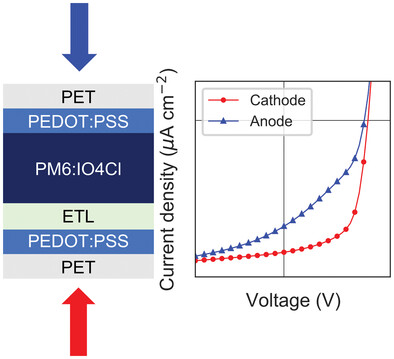Rodríguez-Martínez, X., Hartnagel, P., Riera-Galindo, S., Beket, G., Österberg, T., Gao, F., Kirchartz, T., Inganäs, O.
Adv. Funct. Mater. 2023, 33, 2301192
Non-fullerene acceptors have recently revolutionized indoor organic photovoltaics (OPVs) with power conversion efficiencies exceeding 30% in laboratory scale. Nevertheless, transferring their superior performance to larger-scale prototyping, i.e., air-processing via roll-to-roll compatible techniques, still shows severe challenges. Herein, the industrial potential of the PM6:IO4Cl blend, which is one of the most successful indoor OPV photoactive layers (PALs), is thoroughly investigated. The corresponding thick and semitransparent laminated devices are fabricated entirely in air, by blade and slot-die coating. Their current–voltage (J–V) characteristics show anomalous features depending on the illumination side, with the cathode side generally outperforming the anode counterpart. Electrical and optical modeling reveal that a plausible cause of such a phenomenon is a dead layer that forms at the PAL/anode contact interface that does not contribute to the photocurrent. Said layer becomes undetectable when the PALs are made thin enough (<35 nm each) leading to symmetric J–V curves and improved light utilization efficiency. By screening the photovoltaic performance of multiple donor:acceptor blends, certain all-polymer and polymer:fullerene PALs are identified as adequately symmetric candidates for thick device up-scaling. Finally, ternary blends based on PM6:IO4Cl:fullerene may constitute a viable route to mitigate the electrical asymmetry detected on conventional binary blends.

Rodríguez-Martínez, X., Hartnagel, P., Riera-Galindo, S., Beket, G., Österberg, T., Gao, F., Kirchartz, T., Inganäs, O.
Adv. Funct. Mater. 2023, 33, 2301192
Non-fullerene acceptors have recently revolutionized indoor organic photovoltaics (OPVs) with power conversion efficiencies exceeding 30% in laboratory scale. Nevertheless, transferring their superior performance to larger-scale prototyping, i.e., air-processing via roll-to-roll compatible techniques, still shows severe challenges. Herein, the industrial potential of the PM6:IO4Cl blend, which is one of the most successful indoor OPV photoactive layers (PALs), is thoroughly investigated. The corresponding thick and semitransparent laminated devices are fabricated entirely in air, by blade and slot-die coating. Their current–voltage (J–V) characteristics show anomalous features depending on the illumination side, with the cathode side generally outperforming the anode counterpart. Electrical and optical modeling reveal that a plausible cause of such a phenomenon is a dead layer that forms at the PAL/anode contact interface that does not contribute to the photocurrent. Said layer becomes undetectable when the PALs are made thin enough (<35 nm each) leading to symmetric J–V curves and improved light utilization efficiency. By screening the photovoltaic performance of multiple donor:acceptor blends, certain all-polymer and polymer:fullerene PALs are identified as adequately symmetric candidates for thick device up-scaling. Finally, ternary blends based on PM6:IO4Cl:fullerene may constitute a viable route to mitigate the electrical asymmetry detected on conventional binary blends.